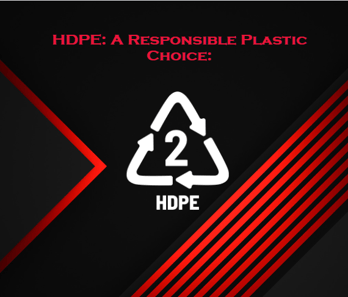Rethinking Plastics: Understanding the Benefits of HDPE and its Positive Role in a Sustainable Future

Unveiling the Sustainable Potential of HDPE in a Changing World
Introduction: Plastics have become a topic of increasing concern due to their environmental impact and contribution to pollution. However, it is important to recognize that not all plastics are created equal. High-density polyethylene (HDPE) stands out as a material with significant advantages and a positive role to play in a sustainable future. In this blog, we will explore why society's dislike for plastic should be reevaluated, and how HDPE, in particular, can be a responsible and environmentally friendly choice.
-
The Complexity of the Plastic Problem: The negative perception of plastics arises from the persistence and improper disposal of certain types, leading to pollution, waste accumulation, and harm to ecosystems. However, it is crucial to differentiate between different plastic materials based on their properties and environmental impact. HDPE is an example of a plastic that offers distinct benefits and aligns with sustainable practices.
-
HDPE: A Responsible Plastic Choice:
a. Durability and Longevity: HDPE is known for its exceptional durability and longevity. It can withstand demanding conditions, ensuring that products made from HDPE have a long lifespan. This reduces the need for frequent replacements, minimizing waste and resource consumption.
b. Recyclability and Circular Economy: HDPE is a highly recyclable plastic. It can be melted and reshaped into new products, promoting a circular economy approach. By recycling HDPE, we can conserve resources, reduce energy consumption, and divert plastic waste from landfills and the environment.
c. Reduced Carbon Footprint: Compared to other materials, HDPE has a lower carbon footprint during production. Its lightweight nature allows for efficient transportation, reducing energy requirements and greenhouse gas emissions. Additionally, HDPE manufacturing processes continue to evolve, becoming more energy-efficient and utilizing renewable energy sources.
- HDPE in Sustainable Applications:
a. Packaging Solutions: HDPE is widely used in packaging applications, such as bottles, containers, and bags. Its durability and chemical resistance make it suitable for safely storing and transporting various products. By utilizing HDPE packaging, companies can reduce food waste, ensure product integrity, and minimize the need for single-use alternatives.
b. Construction and Infrastructure: HDPE's strength, resistance to moisture, and chemical durability make it valuable in construction and infrastructure projects. Applications include pipes for water and gas distribution, geomembranes for environmental protection, and insulation materials. HDPE's longevity reduces the need for frequent repairs or replacements, saving resources in the long run.
c. Agricultural Innovations: In agriculture, HDPE finds application in greenhouse films, irrigation systems, and silage covers. Its moisture resistance, flexibility, and durability contribute to efficient water management, crop protection, and preservation of animal feed. This promotes sustainable agricultural practices and improves resource efficiency.
Conclusion:
While society's general dislike for plastic is understandable, it is crucial to differentiate between different types of plastics and their environmental impact. HDPE stands as a responsible choice within the plastic realm, offering durability, recyclability, a reduced carbon footprint, and a range of sustainable applications. By embracing HDPE and supporting its responsible use, we can harness the benefits of this material while minimizing its environmental consequences. The focus should shift towards improving plastic waste management, promoting recycling initiatives, and encouraging the responsible production and use of materials like HDPE, ultimately leading us towards a more sustainable and plastic-conscious future.

